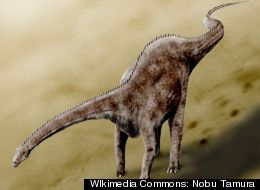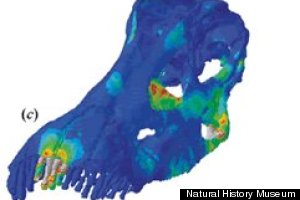Posted: 07/18/2012 12:52 pm Updated: 07/18/2012 1:15 pm
Call it a prehistoric paradox. Huge herbivorous dinosaurs like Diplodocus—at about 30 meters in length, one of the longest dinos ever discovered—needed to consume vast quantities of plants. And yet scientists have puzzled for years over the Diplodocus’ long snout and protruding, peglike teeth--which don't look like the right equipment for the job.
With the help of finite element analysis—an imaging technology commonly used in airplane design—a team of researchers created a 3D model of the Diplodocus skull and used it to figure out just how the dinosaur dined.

Diplodocus’ eating habits have been revealed by a
technique called finite element analysis.
The study, published July 16, 2012 in the Journal Naturwissenschaften, suggests that Diplodocus was actually capable of two feeding techniques: precision biting and raking leaves off of branches with its teeth.
"Our results show that there is no biomechanical reason to reject either hypothesis or that Diplodocus was capable of both," researcher Dr. Mark Young, a geoscientist at the University of Edinburgh, told The Huffington Post in an e-mail.
The idea that Diplodocus was a branch-stripper had been around since the mid-1970s, according to Dr. Paul Barrett, a paleontologist at the Natural History Museum in London. But the idea was controversial because the skull appeared too lightly built to allow that behavior.
"What our new work does is to look at the skull from an engineering viewpoint, providing the first really rigorous test of this idea," Barrett told The Huffington Post in an e-mail. "What it shows is that the skull would have been able to withstand the forces from both regular biting, not a surprise, and branch-stripping."
Young suggested that the unusual skull shape of Diplodocus, with teeth restricted to the front of the jaw, actually could have helped this feeding style.
"This would allow them to maximize the amount of food ingested per bite. By not chewing their food, they could swallow as much as possible.
Whether this allowed them to grow as large as they did, or whether growing so large meant they stopped orally processing their food and shifted to ingesting as much as possible is currently unclear," Young said.
The CT scans showed that Diplodocus' skull received stress around the teeth and below the eye socket when eating.

CT scan images of a Diplodocus skull showing the feeding scenario of branch-stripping, as published in Naturwissenschaften. Red, orange, yellow, green, then light blue indicate the greater stress.
"The bones that housed the teeth and those which surrounded the brain are exceptionally thick, whereas the facial bones are extremely thin. The CT scan data also shows how many replacement teeth are behind each tooth, usually four," Young said. "These animals would have been constantly replacing teeth, possibly as frequently as every month."
 DISCUSSION
GROUP
DISCUSSION
GROUP



Write a comment
chef uniforms (Friday, 02 November 2012 02:24)
Your contents are progressing with days keep it up guys.
chef jackets (Thursday, 31 January 2013)
It feels awesome to read such informative and unique articles on your websites.